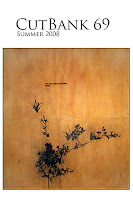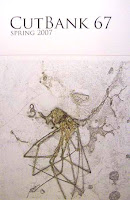
Making the desert empty. Bloom, purging soil. As though it needed a little
more room. All the toil, come from countries: “Waste not, want not” once
its pride. Now its eyes for the world are wide. And nothing it does upsets
us. There’s no apartheid in its midst. There’s no lie, we need the fence….
Wandering though the land like Christ. Take that village along the ridge.
Who on earth could bring it help? Ethnic cleansing, Scripture says. Slowly
but surely. Staying strong is hardly wrong; our forces do what must be
done. Nothing that they do is fun. Living along this seam. Where is, in fact
is what it seems. If you will it, said the prophet. It is not a dream.
(From “What Has Been Prepared, Part III: What Intimation Is There,” 80)
Reading Peter Cole’s memorable poetry volume, Things On Which I’ve Stumbled, with the assault on Gaza raging, is an emotionally charged and revealing experience. Dense, coherent, confessional, and prophetic, his writings explore an archeology of mystical fragments, from poetry manuscripts unearthed in an old Egyptian synagogue to uncensored personal thoughts and observations about the political plight of modern Jerusalem. Even the arresting book cover — a Joel Shapiro woodcut of a disjointed black swastika — is in itself a telling political commentary. Indeed, writing about the identity of a nation and people in the context of Jerusalem and Palestine is both sacred and political, as demonstrated in this concise poem now oft cited and remembered:
Most of the poems in this collection are allegorical and meditative. Often, the titles are illustrative. Consider these: “The Ghazal of What He Sees,” “Proverbial Drawing: How Far, A Right Angle Supports Us Here, The Line, It’s True, The House The Cloud, The Wrong Angle Righted,” “The Ghazal of What Hurt.” From open-form lyrics and sestinas to ghazals, lineated prose, and prose-poems, the variety of forms and modes in this collection is both refined and rich. Cole has boldly incorporated an Arabic cadence into his well-composed English syntax, sometimes seeking more of a musical cadence than a strict adherence to metric feet in his prosodic eloquence. Much of the twenty-three-page title poem, “Things on Which I’ve Stumbled,” for instance, contains a visible architectural elegance and clarity that renders an incantatory touch to parallel words and refrains, as well as illuminating blank but breathing spaces:
These are things I could not fathom,
………. your sons
……………. your ways
……………………..your …….
Plunders of a people
………. in darkness (24)
how what is smallest could loom so large,
how what is best could miss what is finest
….
and how what is fine
and wine
could be crushed by a blindness
Tell me, what is man
If not dirt and a worm,
his life is only vapor…
caused by a brightness
Tell me what man is
but flesh and blood that’s warm,
reaching the margins
of what it is
whose life is only vapor… (28)
Despite their experimental forms, all of the poems are clear and accessible in their messages, paying close attention to linguistic nuances and techniques. Cole creates a range of lyrical episodes, either expressing a single narrative voice or a multivocality in which voices from different time periods intersect. I found many lines irresistibly ludic yet resonating, despite their seeming simplicity:
In the poem “Why Does the World Out There Seem,” the poet states, “Poems, as Williams wrote, are machines.” Peter Cole joins the ranks of poets such as Paul Celan, Allen Ginsberg and Bei Dao who articulate serious questions about the place of poetry in a darkened and dubious world. Things On Which I’ve Stumbled asserts a union between language and meaning in the context of a specific culture. What stands out clear to me is that one cannot read this volume without acknowledging its moral seriousness, its historical and cultural references. While savoring their many and layered musics, I have also enjoyed the verses as a combination of Cole’s emotional and intellectual responses, whether as poet or translator.
**
An acclaimed translator of Hebrew and Arabic poetry, Peter Cole’s previous volumes of poems are compiled in What Is Doubled: Poems 1981-1998. His several translations from the Hebrew and Arabic include poetry by Taha Muhammad Ali, Aharon Shabtai, Yoel Hoffmann, and others. Awards and fellowships include a PEN Translation Prize for Poetry, a TLS Translation Prize, a Guggenheim Foundation Fellowship and a MacArthur Foundation Fellowship. He lives in Jerusalem, and is co-editor of Ibis Editions.
**
Fiona Sze-Lorrain (www.fionasze.com) publishes poetry and non-fiction under her nom-de-plume, Greta Aart. Her forthcoming poems can be found in Broken Plate, Caesura, Santa Clara Review, River Oak Review, Istanbul Literary Review, etc. Also a harp concertist, she lives in Paris, France.
Israel is he, or she, who wrestles
with God — call him what you will,
not some goon (with a rabbi and gun)
in a pre-fab home on a biblical hill.
(From “Israel Is,” 50)
Most of the poems in this collection are allegorical and meditative. Often, the titles are illustrative. Consider these: “The Ghazal of What He Sees,” “Proverbial Drawing: How Far, A Right Angle Supports Us Here, The Line, It’s True, The House The Cloud, The Wrong Angle Righted,” “The Ghazal of What Hurt.” From open-form lyrics and sestinas to ghazals, lineated prose, and prose-poems, the variety of forms and modes in this collection is both refined and rich. Cole has boldly incorporated an Arabic cadence into his well-composed English syntax, sometimes seeking more of a musical cadence than a strict adherence to metric feet in his prosodic eloquence. Much of the twenty-three-page title poem, “Things on Which I’ve Stumbled,” for instance, contains a visible architectural elegance and clarity that renders an incantatory touch to parallel words and refrains, as well as illuminating blank but breathing spaces:
These are things I could not fathom,
………. your sons
……………. your ways
……………………..your …….
Plunders of a people
………. in darkness (24)
how what is smallest could loom so large,
how what is best could miss what is finest
….
and how what is fine
and wine
could be crushed by a blindness
Tell me, what is man
If not dirt and a worm,
his life is only vapor…
caused by a brightness
Tell me what man is
but flesh and blood that’s warm,
reaching the margins
of what it is
whose life is only vapor… (28)
Despite their experimental forms, all of the poems are clear and accessible in their messages, paying close attention to linguistic nuances and techniques. Cole creates a range of lyrical episodes, either expressing a single narrative voice or a multivocality in which voices from different time periods intersect. I found many lines irresistibly ludic yet resonating, despite their seeming simplicity:
No! It’s all in the picture,
which this one echoes:
“I want, I want,” said Blake.
“I can’t, I can’t,” said the fake.
(From “Proverbial Drawing, Part I: How Far,” 51)
In the poem “Why Does the World Out There Seem,” the poet states, “Poems, as Williams wrote, are machines.” Peter Cole joins the ranks of poets such as Paul Celan, Allen Ginsberg and Bei Dao who articulate serious questions about the place of poetry in a darkened and dubious world. Things On Which I’ve Stumbled asserts a union between language and meaning in the context of a specific culture. What stands out clear to me is that one cannot read this volume without acknowledging its moral seriousness, its historical and cultural references. While savoring their many and layered musics, I have also enjoyed the verses as a combination of Cole’s emotional and intellectual responses, whether as poet or translator.
**
An acclaimed translator of Hebrew and Arabic poetry, Peter Cole’s previous volumes of poems are compiled in What Is Doubled: Poems 1981-1998. His several translations from the Hebrew and Arabic include poetry by Taha Muhammad Ali, Aharon Shabtai, Yoel Hoffmann, and others. Awards and fellowships include a PEN Translation Prize for Poetry, a TLS Translation Prize, a Guggenheim Foundation Fellowship and a MacArthur Foundation Fellowship. He lives in Jerusalem, and is co-editor of Ibis Editions.
**
Fiona Sze-Lorrain (www.fionasze.com) publishes poetry and non-fiction under her nom-de-plume, Greta Aart. Her forthcoming poems can be found in Broken Plate, Caesura, Santa Clara Review, River Oak Review, Istanbul Literary Review, etc. Also a harp concertist, she lives in Paris, France.




